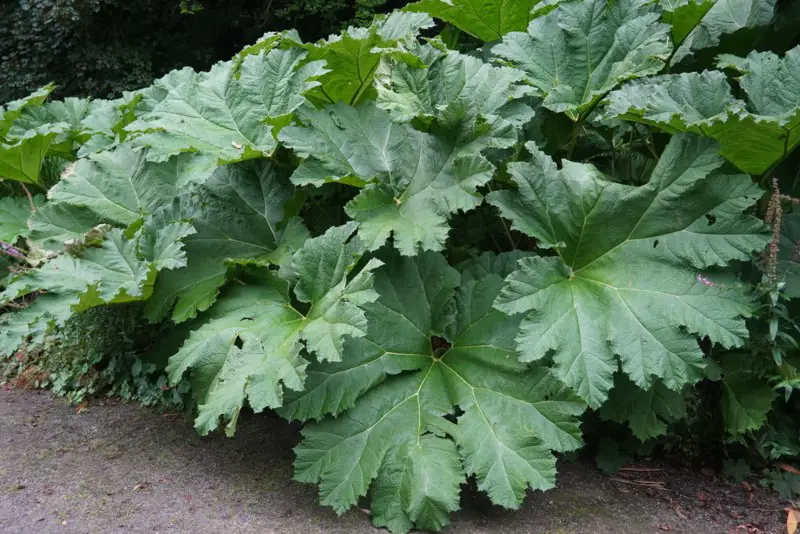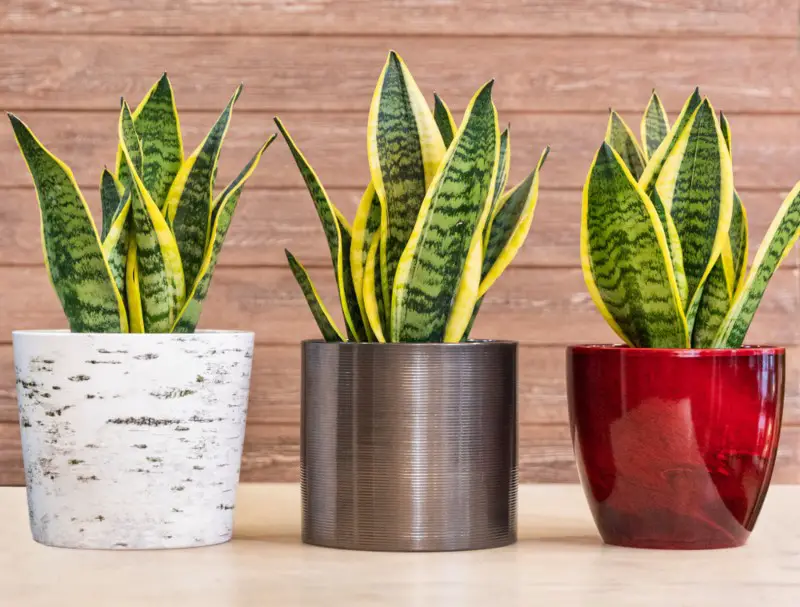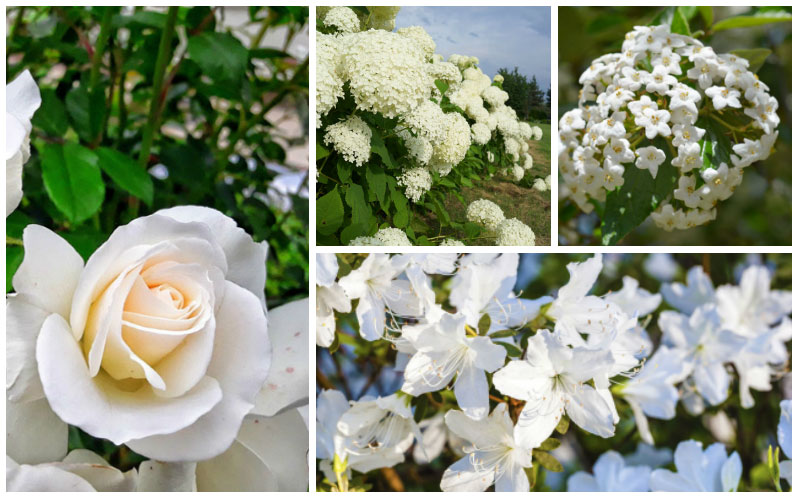
Outdoor plants with large leaves can draw the eye and improve the overall look of your garden. If you are looking to add color and character to your outdoor spaces, as well as fill in any blank spots in your garden with big, eye-catching leaves, we are here to help!
To make things simple, we have listed 20 of our favorite big leaf outdoor plants. We will provide their names, as well as some of their characteristics and requirements, so you can find the perfect plants to fill out your gardens!
1. Rubber Fig (Ficus elastica)

The rubber fig requires relatively little care and its large, dark green leaves give the plant a stunning appearance. They tend to do well when exposed to bright, indirect sunlight and usually thrive with a twice-per-week watering schedule. If they have enough space, they can grow incredibly large, so consider using a pot if you want to keep the size down.
They also prefer heat and humidity, so you should aim to cover the roots with at least a few inches of mulch, which will help keep the soil moist.
2. Swiss Cheese Plant (Monstera deliciosa)

The swiss cheese plant is one of the most unique large leaf plants you can grow. As the name suggests, the leaves have small circular holes reminiscent of Swiss cheese.
The unique leaves can grow up to three feet long, and the plant prefers very rich soil. They are also climbers, so consider planting them near a tree or fence. They prefer filtered sunlight and a humid climate, as they originate from the jungles of Mexico.
3. Giant Taro (Alocasia macrorrhiza)

The massive, dramatic leaves of the giant taro plant can give any garden a lush, full look. The large, bright green leaves grow in an upright position and reach three to six feet in length. Whether they are grown in a garden or a container, they add an exotic look, sure to draw the eye.
They prefer partial shade in rich, moist soil. Plant them somewhere where they are sheltered from the wind, and be sure to fertilize regularly.
4. Giant Rhubarb (Gunnera tinctoria)

Giant rhubarb plants have massive leaves that can grow up to 6 feet in width. The leaves remain dark green throughout the year, and their coarse, ruffled texture can add a distinct look to your garden.
The plant does best in full sunlight, but it will also thrive in partial shade. It prefers moist soil to wet soil, and it is very difficult to over-water. They prefer rich soil but actually do well in just about any soil once the roots have taken hold.
5. Dumbcane (Dieffenbachia seguine)

Dumbcane, or tuftroot, is a common houseplant; however, as long as you plant it in the right location, it will also do well outdoors. The large leaves are white and green, and they can add plenty of ornamental value.
It will grow best in partial shade; however, it doesn’t do well with cold air temperatures and can die when exposed. They thrive in humid conditions, and it is important to provide them with plenty of water and fertilizer. Aim for a well-draining soil, as the plant can be susceptible to root rot.
6. Umbrella Plant (Darmera peltata)

The large, lily-pad-like leaves of the umbrella plant look stunning, and the plant even flowers during the spring months. They do well in moist soil; however, it is worth noting that it can be an aggressive plant, so give it plenty of space. It prefers partial to full shade and is easy to grow.
7. Siberian Bugloss (Brunnera macrophylla)

This small-stature plant is known for its large, dark green and white leaves. The leaves have an attractive shape and coloration, and the plant is fairly easy to grow outdoors. It prefers rich soil; however, it must have good drainage, as they do not do well in soggy conditions. Avoid direct sunlight and, instead, opt for partial shade.
8. Hostas

Hostas, or plantain lilies as they are also known, are quintessential large leaf outdoor plants. These popular garden plants come in many sizes and colors, but they all feature the same iconic, heart-shaped leaves.
They prefer moist yet well-drained soil and tend to do best when exposed to full or partial shade.
9. Mayapple (Podophyllum peltatum)

Mayapple is a plant that grows naturally throughout much of North America. The leaves are quite large, and they have a unique shape. The plant is quite hearty, especially if you live on the east coast.
Ideally, you should plant them in rich, moist soil loaded with organic matter, so you should consider composting. These plants also require partial or full shade, so keep them out of direct sunlight.
10. Common Rhubarb (Rheum rhabarbarum)

Unlike giant rhubarb, the common variety of rhubarb is edible, so it is common in vegetable gardens. While it is not as large as its giant cousin, Common Rhubarb also has impressively large leaves.
Even if you do not plan on harvesting the edible stems, the plant can make a bold statement in an ornamental garden. Plant it in a full sun location that has good drainage. It works well in rich soil and thrives with compost, manure, and other organic matter.
11. Colewort (Crambe cordifolia)

This plant produces tall, white flowers during the summer months, but its large, green leaves catch the eye throughout the year.
The plant prefers fertile, well-drained soil and full sun exposure. With that said, it can tolerate poor soil and partial shade, but this can mean the plant will not flower or grow nearly as large.
12. Snake Plant (Sansevieria trifasciata)

The snake plant is an incredibly popular houseplant, but in the right conditions, it does well outdoors. The large, stiff leaves grow upwards, and they can vary in color. An outdoor Snake Plant makes a statement in any garden.
They prefer warmer temperatures and do best when exposed to bright, indirect sunlight. Just make sure you do not over-water the plant, as this almost always leads to root rot and yellowing of the leaves.
13. Ligularia

The giant, coarse leaves of Ligularia plants make a statement in any shady garden. The large leaves usually have a jagged and triangular shape, and they can turn a nice shade of burgundy during the spring months.
These plants require constant moisture, so they are difficult plants to care for. Use soil that can hold moisture, and they also thrive when the roots are covered in compost. They also do best with partial sun exposure.
14. Japanese Butterbur (Petasites japonicus)

This large-leaved perennial grows quite tall and has a dramatic appearance. The large, round leaves can grow as large as 50 inches in width.
It will grow best in soggy soil, which is why many people plant them near ponds, streams, and other water features. It prefers partial or full shade and will tolerate just about any soil, as long as it is moist. Keep in mind that it can be an aggressive plant that spreads quite quickly.
15. Swiss Chard (Beta vulgaris)

Swiss chard is another plant that is a common sight in vegetable gardens, but just like common rhubarb, you can plant it for its aesthetic value. The large, crinkled leaves and bright red stems catch the eye.
The plant prefers loose and fertile soil that is rich in organic matter. It requires plenty of moisture, so be prepared for a busy watering schedule. It will grow best in full sun but can easily tolerate shady conditions.
16. Canna Lilies (Canna indica)

Cannas have large, paddle-like leaves that often grow in a light green shade; however, you can find them in eye-catching shades of purple. While they look brilliant, they do not do well in cold temperatures, which is why they are usually planted around the same time as tomato plants. They need plenty of sunshine and fertile, moist soil.
17. Ginger Lily (Hedychium)

The ginger lily also has paddle-like leaves that look fantastic in any jungle-themed garden. They require soil that has outstanding drainage; however, they do need frequent watering. They prefer partial shade and tend to grow fairly tall.
18. Taliflower (Anthurium)

While they are often grown as houseplants, they also do well as outdoor landscaping plants. They can tolerate many lighting conditions, but the direct sun can burn their large, dark green leaves. Make sure to water the plant regularly and use well-draining soil.
19. West Indian Kale (Colocasia esculenta)

The large, deep green leaves of this tropical plant look amazing in any garden. They are also known as elephant ear plants, which is due to the unique shape of their large, drooping leaves. They require moist soil and a regular fertilizing schedule. They prefer warm climates; however, they do best with partial sun.
20. Fiddle Leaf Fig Plant (Ficus lyrata)

This popular indoor plant is native to the tropical regions of Africa. While it is usually a houseplant, you can plant it outdoors. With that said, it requires warm and wet conditions. Partial shade and well-draining soil work best. Most people find they have the most luck when they keep the Fiddle Leaf inside a pot, even if it is outdoors.













